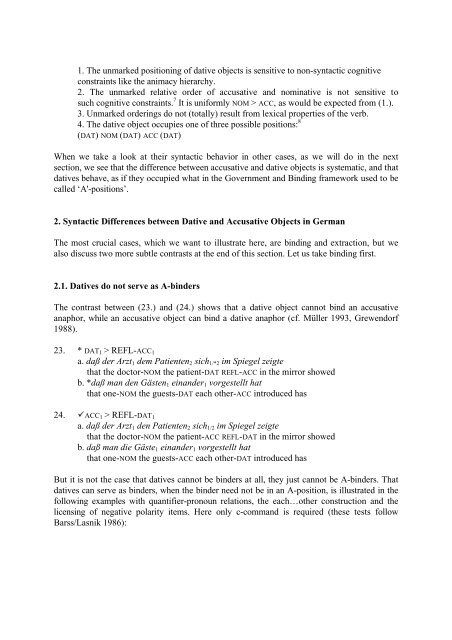The Dative – an Oblique Case
The Dative – an Oblique Case
The Dative – an Oblique Case
Create successful ePaper yourself
Turn your PDF publications into a flip-book with our unique Google optimized e-Paper software.
1. <strong>The</strong> unmarked positioning of dative objects is sensitive to non-syntactic cognitive<br />
constraints like the <strong>an</strong>imacy hierarchy.<br />
2. <strong>The</strong> unmarked relative order of accusative <strong>an</strong>d nominative is not sensitive to<br />
such cognitive constraints. 7 It is uniformly NOM > ACC, as would be expected from (1.).<br />
3. Unmarked orderings do not (totally) result from lexical properties of the verb.<br />
4. <strong>The</strong> dative object occupies one of three possible positions: 8<br />
(DAT) NOM (DAT) ACC (DAT)<br />
When we take a look at their syntactic behavior in other cases, as we will do in the next<br />
section, we see that the difference between accusative <strong>an</strong>d dative objects is systematic, <strong>an</strong>d that<br />
datives behave, as if they occupied what in the Government <strong>an</strong>d Binding framework used to be<br />
called ‘A'-positions’.<br />
2. Syntactic Differences between <strong>Dative</strong> <strong>an</strong>d Accusative Objects in Germ<strong>an</strong><br />
<strong>The</strong> most crucial cases, which we w<strong>an</strong>t to illustrate here, are binding <strong>an</strong>d extraction, but we<br />
also discuss two more subtle contrasts at the end of this section. Let us take binding first.<br />
2.1. <strong>Dative</strong>s do not serve as A-binders<br />
<strong>The</strong> contrast between (23.) <strong>an</strong>d (24.) shows that a dative object c<strong>an</strong>not bind <strong>an</strong> accusative<br />
<strong>an</strong>aphor, while <strong>an</strong> accusative object c<strong>an</strong> bind a dative <strong>an</strong>aphor (cf. Müller 1993, Grewendorf<br />
1988).<br />
23. * DAT1 > REFL-ACC1<br />
a. daß der Arzt1 dem Patienten2 sich1/*2 im Spiegel zeigte<br />
that the doctor-NOM the patient-DAT REFL-ACC in the mirror showed<br />
b. *daß m<strong>an</strong> den Gästen1 ein<strong>an</strong>der1 vorgestellt hat<br />
that one-NOM the guests-DAT each other-ACC introduced has<br />
24. �ACC1 > REFL-DAT1<br />
a. daß der Arzt1 den Patienten2 sich1/2 im Spiegel zeigte<br />
that the doctor-NOM the patient-ACC REFL-DAT in the mirror showed<br />
b. daß m<strong>an</strong> die Gäste1 ein<strong>an</strong>der1 vorgestellt hat<br />
that one-NOM the guests-ACC each other-DAT introduced has<br />
But it is not the case that datives c<strong>an</strong>not be binders at all, they just c<strong>an</strong>not be A-binders. That<br />
datives c<strong>an</strong> serve as binders, when the binder need not be in <strong>an</strong> A-position, is illustrated in the<br />
following examples with qu<strong>an</strong>tifier-pronoun relations, the each…other construction <strong>an</strong>d the<br />
licensing of negative polarity items. Here only c-comm<strong>an</strong>d is required (these tests follow<br />
Barss/Lasnik 1986):

















